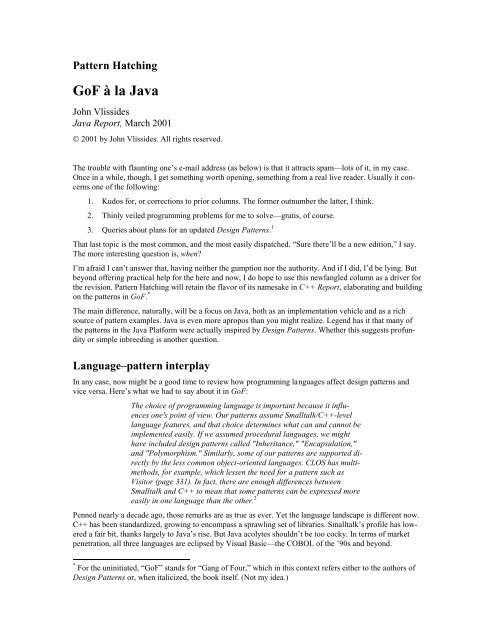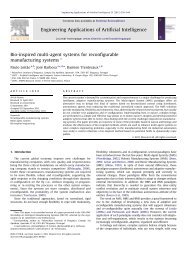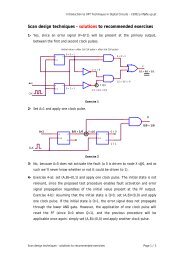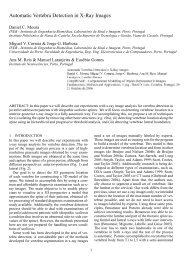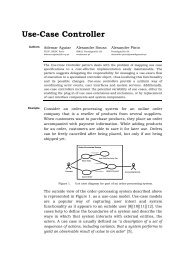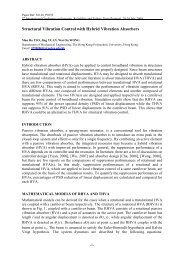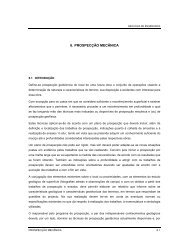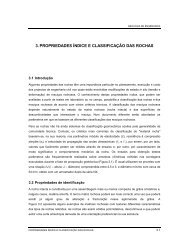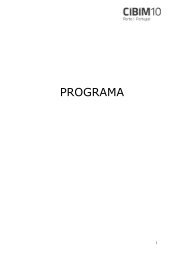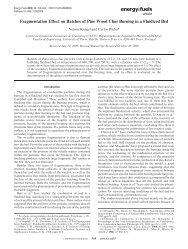Download as a PDF - CiteSeerX
Download as a PDF - CiteSeerX
Download as a PDF - CiteSeerX
You also want an ePaper? Increase the reach of your titles
YUMPU automatically turns print PDFs into web optimized ePapers that Google loves.
Pattern Hatching<br />
GoF à la Java<br />
John Vlissides<br />
Java Report, March 2001<br />
© 2001 by John Vlissides. All rights reserved.<br />
The trouble with flaunting one’s e-mail address (<strong>as</strong> below) is that it attracts spam—lots of it, in my c<strong>as</strong>e.<br />
Once in a while, though, I get something worth opening, something from a real live reader. Usually it concerns<br />
one of the following:<br />
1. Kudos for, or corrections to prior columns. The former outnumber the latter, I think.<br />
2. Thinly veiled programming problems for me to solve—gratis, of course.<br />
3. Queries about plans for an updated Design Patterns. 1<br />
That l<strong>as</strong>t topic is the most common, and the most e<strong>as</strong>ily dispatched. “Sure there’ll be a new edition,” I say.<br />
The more interesting question is, when?<br />
I’m afraid I can’t answer that, having neither the gumption nor the authority. And if I did, I’d be lying. But<br />
beyond offering practical help for the here and now, I do hope to use this newfangled column <strong>as</strong> a driver for<br />
the revision. Pattern Hatching will retain the flavor of its namesake in C++ Report, elaborating and building<br />
on the patterns in GoF. *<br />
The main difference, naturally, will be a focus on Java, both <strong>as</strong> an implementation vehicle and <strong>as</strong> a rich<br />
source of pattern examples. Java is even more apropos than you might realize. Legend h<strong>as</strong> it that many of<br />
the patterns in the Java Platform were actually inspired by Design Patterns. Whether this suggests profundity<br />
or simple inbreeding is another question.<br />
Language–pattern interplay<br />
In any c<strong>as</strong>e, now might be a good time to review how programming languages affect design patterns and<br />
vice versa. Here’s what we had to say about it in GoF:<br />
The choice of programming language is important because it influences<br />
one's point of view. Our patterns <strong>as</strong>sume Smalltalk/C++-level<br />
language features, and that choice determines what can and cannot be<br />
implemented e<strong>as</strong>ily. If we <strong>as</strong>sumed procedural languages, we might<br />
have included design patterns called "Inheritance," "Encapsulation,"<br />
and "Polymorphism." Similarly, some of our patterns are supported directly<br />
by the less common object-oriented languages. CLOS h<strong>as</strong> multimethods,<br />
for example, which lessen the need for a pattern such <strong>as</strong><br />
Visitor (page 331). In fact, there are enough differences between<br />
Smalltalk and C++ to mean that some patterns can be expressed more<br />
e<strong>as</strong>ily in one language than the other. 2<br />
Penned nearly a decade ago, those remarks are <strong>as</strong> true <strong>as</strong> ever. Yet the language landscape is different now.<br />
C++ h<strong>as</strong> been standardized, growing to encomp<strong>as</strong>s a sprawling set of libraries. Smalltalk’s profile h<strong>as</strong> lowered<br />
a fair bit, thanks largely to Java’s rise. But Java acolytes shouldn’t be too cocky. In terms of market<br />
penetration, all three languages are eclipsed by Visual B<strong>as</strong>ic—the COBOL of the ’90s and beyond.<br />
* For the uninitiated, “GoF” stands for “Gang of Four,” which in this context refers either to the authors of<br />
Design Patterns or, when italicized, the book itself. (Not my idea.)
2 GoF à la Java<br />
Another big change is the expanded role libraries play in the programming drama. Smalltalkers may scoff at<br />
the “newness” of that role, but they won’t deny its importance. Time w<strong>as</strong> when you could be productive<br />
with a new language after spending a few hours learning its syntax. No longer. These days, programming<br />
takes more than a knowledge of language constructs; fluency also requires knowing how to work the libraries<br />
that come with a language.<br />
That’s good news for pattern fans. Modern libraries are highly likely to harbor design patterns, even libraries<br />
for non-object-oriented languages. Not one but two recent books are devoted to patterns in Visual B<strong>as</strong>ic,<br />
of all things. 3,4 Both describe pattern instances in the VB platform and how to implement them yourself.<br />
Meanwhile, Jezequel, et al. 5 have done a similar service for Eiffel, a niche OO language. (Demonstrating,<br />
by the way, that a language community doesn’t have to be big to be vibrant.) Alexandrescu’s GPI library 6<br />
takes this trend to its logical conclusion, simplifying pattern implementation in C++ through the magic of<br />
template metaprogramming.<br />
Design patterns in the JDK<br />
For their part, the Java libraries have been larded with patterns from the beginning. Erich Gamma wrote a<br />
nice article on that topic way back in 1996, 7 not long after Java’s debut (and this magazine’s). Old-timers<br />
will recall how those were the 1.0 days, back when AWT ruled. Swing, Listeners, and inner cl<strong>as</strong>ses were all<br />
yet to be.<br />
Even so, that article is still illuminating on many counts. Erich shows how the original Java team—<br />
knowingly or unknowingly—made patterns “dovetail and intertwine to create a greater whole.” Focusing on<br />
AWT, he details the application of no fewer than five GoF patterns to five b<strong>as</strong>e cl<strong>as</strong>ses:<br />
1. The relationship between Component and Container reflects the COMPOSITE pattern, Component<br />
(oddly enough) playing the Component role, with Container <strong>as</strong> the Composite.<br />
2. Container also plays the Context role in the STRATEGY pattern. LayoutManager is c<strong>as</strong>t <strong>as</strong> the Strategy.<br />
LayoutManager subcl<strong>as</strong>ses implement different GUI layouts in a declarative way: FlowLayout<br />
for laying out components <strong>as</strong> you would text, GridLayout for row-column arrangements, and so<br />
forth.<br />
3. Component and ComponentPeer exempify the BRIDGE pattern, with Component <strong>as</strong> the Abstraction<br />
and ComponentPeer <strong>as</strong> the Implementor. ConcreteImplementors like Win32ButtonPeer and MotifButtonPeer<br />
encapsulate actual widgets from Win32 and Motif, respectively. This w<strong>as</strong> key to<br />
AWT’s cross-platform GUI capabilities, such <strong>as</strong> they were.<br />
4. Supporting BRIDGE in the write-once-run-everywhere objective is an application of ABSTRACT<br />
FACTORY. The Toolkit cl<strong>as</strong>s is an AbstractFactory whose concrete subcl<strong>as</strong>ses bind AbstractProducts<br />
(Button, Dialog, etc.) to native toolkit implementations.<br />
5. It didn’t make sense to allow more than one instance of Toolkit at a time, hence the application of<br />
the SINGLETON pattern to prevent it.<br />
Erich illustrated these relationships using a notation he later dubbed “pattern-role annotations.” I’ve recreated<br />
his diagram in Figure 1, replacing the vintage OMT notation he used with UML.<br />
It still amazes me to see this many patterns stuffed into so few cl<strong>as</strong>ses, and to good effect. You can create a<br />
fine mess with too many patterns, but that didn’t happen here. They impart no functionality or flexibility<br />
that isn’t needed. Besides, no cl<strong>as</strong>s participates in more than two patterns except Component, which won’t<br />
tax the intellect. To paraphr<strong>as</strong>e Mr. Iacocca, if you can find a better cl<strong>as</strong>s design, build it.<br />
Pattern Hatching Java Report March 2001
GoF à la Java 3<br />
ComponentPeer<br />
Bridge : Implementor<br />
Abstract Factory : Product<br />
Toolkit<br />
Abstract Factory<br />
Singleton<br />
1 1<br />
1 1<br />
Component<br />
Composite<br />
Strategy : Context<br />
Figure 1: Patterns in AWT<br />
Composite : Component<br />
Bridge : Abstraction<br />
Abstract Factory : Client<br />
layoutMgr<br />
1 1<br />
Container LayoutManager<br />
1 1<br />
Strategy<br />
Of course, Erich w<strong>as</strong> barely scratching the surface in his article. There are many more pattern manifestations<br />
in the original Java libraries, and the number only incre<strong>as</strong>es in subsequent versions. Here are some<br />
examples:<br />
• COMMAND: UndoableEdit, AccessibleAction<br />
• DECORATOR: FilterReader, FilterWriter<br />
• ITERATOR: Enumeration, Iterator<br />
• OBSERVER: Observer/Observable, EventListener/AWTEventMultic<strong>as</strong>ter<br />
• PROXY: Proxy<br />
• FACTORY METHOD, TEMPLATE METHOD, PROTOTYPE: everywhere<br />
The language’s impact<br />
As important and pattern-rich <strong>as</strong> the JDK is, I’d be remiss if I didn’t discuss the Java language proper and<br />
its impact on pattern implementation.<br />
Even though (or perhaps because) our patterns are bi<strong>as</strong>ed toward C++ and Smalltalk implementations, we<br />
use concepts that can’t be expressed directly in either language. For example, we use “interface” to describe<br />
the set of operations in a cl<strong>as</strong>s apart from their implementation. C++ and Smalltalk have no such construct,<br />
which means you have to express interfaces idiomatically, say, through pure virtual functions or by protecting<br />
constructors. Java, on the other hand, supports this idea explicitly through the keyword.<br />
That makes it e<strong>as</strong>y to tell an interface from an abstract cl<strong>as</strong>s (which Java makes explicit <strong>as</strong> well) from a concrete<br />
cl<strong>as</strong>s. The same goes for abstract operations. Another example is the keyword, which lets you<br />
say up front that a cl<strong>as</strong>s cannot be extended or that a method mustn’t be overridden. Little things like these<br />
can make a big difference by bringing a pattern’s implementation closer to its write-up.<br />
Bigger things have an impact, too. Take garbage collection. Even if it can’t guarantee that a program will<br />
use memory sensibly, few will gainsay its benefits. But there are two patterns in particular that it works<br />
wonders for.<br />
The first is SINGLETON, which is famously silent when it comes to reclaiming the Singleton instance. Who<br />
deletes it, when, and how? After discussing the problem a bit in my Pattern Hatching book, 8 I conclude that<br />
any solution short of garbage collection necessarily involves a lot of hackery, at le<strong>as</strong>t in C++. Score another<br />
advantage for Java (and Smalltalk, and Eiffel, and…). I also discuss problems that arise in multithreaded<br />
C++ environments—problems that Java’s synchronization facilities can mitigate, if not solve entirely. 9<br />
The other pattern that profits greatly from garbage collection is FLYWEIGHT. Its gist is to let you enjoy the<br />
benefits of objects even when there are too many of them for your computer’s own good. The pattern shows<br />
you how to use sharing to give the illusion of zillions of objects without incurring the cost. But sharing can<br />
be troublesome: Who’s responsible for deleting a shared object? It’s hard to know in general without extra<br />
bookkeeping, such <strong>as</strong> reference counts. Once again, garbage collection renders the issue moot.<br />
Pattern Hatching Java Report March 2001
4 GoF à la Java<br />
There are other Java language facilities that e<strong>as</strong>e pattern implementation. Here are a few to whet your appetite:<br />
• Packages let you group cl<strong>as</strong>ses and manage their visibility, potentially improving your program’s<br />
modularity and reusability. That’s useful in a wide range of patterns. In BRIDGE, for example, you<br />
can use packages to keep clients ignorant of ConcreteImplementor cl<strong>as</strong>ses. Or you can make a Facade’s<br />
subsystem explicit by putting it in its own package. In fact, you can use packages<br />
consistently to segregate interfaces, abstract cl<strong>as</strong>ses, and concrete cl<strong>as</strong>ses. A package of interfaces<br />
defines a framework; an accompanying package of abstract cl<strong>as</strong>ses adds default implementations.<br />
Packages of concrete cl<strong>as</strong>ses adhering to the framework act like components.<br />
• Inner cl<strong>as</strong>ses tend to reduce the number of top-level cl<strong>as</strong>ses. This is a boon to patterns that are apt<br />
to create a lot of trivial cl<strong>as</strong>ses, like ADAPTER and COMMAND.<br />
• Reflection. Power tools can kill, and reflection is no exception. It can certainly kill performance.<br />
But there are great benefits to be had with reflection when used judiciously. One pattern that can<br />
benefit is VISITOR, specifically to get around the difficulty in adding new ConcreteElement<br />
cl<strong>as</strong>ses. 10 Another is PROXY, <strong>as</strong> evidenced by JDK 1.3’s Dynamic Proxy API. And though I don’t<br />
have a reflection example handy for DECORATOR, it’s a pattern that usually benefits from any language<br />
mechanism that benefits PROXY.<br />
Not quite perfect<br />
Lest you think Java h<strong>as</strong> it all over C++, the latter does have certain advantages, some of them relevant to<br />
patterns. Fairness compels me to mention them:<br />
• A cl<strong>as</strong>s may use to grant access to its private parts, so to speak. can be a useful<br />
scoping mechanism. In MEMENTO, Originators can have privileged access to Mementos by making<br />
the Originators their friends. 11 Java implementations have to rely on other approaches, like type<br />
laundering. 12<br />
• You can fake in Java with final statics, but it’s not the same. No big deal, but once in a while<br />
it’s nice to declare a closed set of tags explicitly, like maybe and .<br />
• More often, you’d like to give a type name an ali<strong>as</strong>, especially when it’s a long and unwieldy<br />
name. You might use to abbreviate , for example, or refer to <br />
simply <strong>as</strong> . lets you do both. It’s particularly useful for the huge<br />
names that can result from deeply nested templates.<br />
• Speaking of which, templates are a world unto themselves, a world I don’t yet fully appreciate.<br />
Fuller appreciation must await their support in Java, since I don’t program in C++ anymore. But<br />
you can sure do <strong>as</strong>tounding things with them, <strong>as</strong> STL and GPI attest.<br />
• Default parameters. I find myself wishing for these when I’m drowning in overloaded methods.<br />
Sometimes you can reduce their number dr<strong>as</strong>tically, even down to one, using default parameters—<br />
specifically, when overloading is there just to provide defaults.<br />
• Multiple implementation inheritance. I know, I know. You don’t need it—normally. Only one of<br />
our patterns uses it (ADAPTER), and even then just <strong>as</strong> one of two variant implementations. However,<br />
friends who build code generators tell me that multiple implementation inheritance would<br />
simplify both the generators and the code they generate. 13<br />
Stay tuned<br />
I must say I’m thrilled and honored to be a columnist for Java Report. As I wind down this inaugural column,<br />
I’m reminded that no matter how familiar a topic seems at the outset, I always end up getting an<br />
education <strong>as</strong> I write about it. I hope you have the same experience with each installment of Pattern Hatching.<br />
Pattern Hatching Java Report March 2001
GoF à la Java 5<br />
Acknowledgments<br />
Many thanks to Erich for the inspiration and to Dirk Riehle for the perspiration.<br />
References<br />
1 Gamma, E., et al. Design Patterns, Addison–Wesley, Reading, MA, 1995.<br />
2 Design Patterns, page 4.<br />
3 Stamatakis, W. Microsoft Visual B<strong>as</strong>ic Design Patterns, Microsoft Press, Redmond, WA, 2000.<br />
4 Griver, Y.A., et al. Visual B<strong>as</strong>ic Developer's Guide to UML and Design Patterns, Sybex, Alameda, CA,<br />
2000.<br />
5 Jezequel, J.-M., et al. Design Patterns and Contracts, Addison–Wesley, Reading, MA, 2000.<br />
6 Alexandrescu, A. Modern C++ Design, Addison–Wesley, Reading, MA, 2001.<br />
7 Gamma, E. “Applying design patterns in Java,” Java Report, November/December 1996, pp. 47–53.<br />
8 Vlissides, J. Pattern Hatching, Addison–Wesley, Reading, MA, 1998, pp. 61–72.<br />
9 Fox, J. “When is a Singleton not a Singleton?”, JavaWorld, http://www.javaworld.com/javaworld/jw-01-<br />
2001/jw-0112-singleton.html.<br />
10 Blosser, J. “Reflect on the VISITOR design pattern,” JavaWorld, http://www.javaworld.com/javatips/jw-<br />
javatip98.html.<br />
11 Design Patterns, p. 287.<br />
12 Pattern Hatching, pp. 102–110.<br />
13 Harrison, H., et al. “Mapping UML Designs to Java,” OOPSLA 2000 Conf. Proc., October 2000,<br />
pp. 178–187.<br />
Pattern Hatching Java Report March 2001


